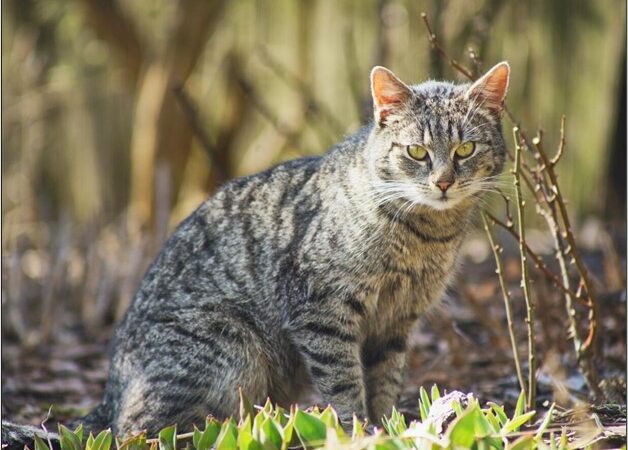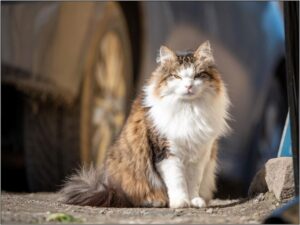ISPCA Highlights Ireland’s Feral Cat Problem.
There are in excess of 200,000 feral cats across Ireland by some estimates. Feral cat overpopulation causes serious welfare concerns and disruption to local communities and eco-systems.
The ISPCA is encouraging members of the public who are in contact with a feral cat colony to take part in Trap, Neuter, and Return (TNR) to help tackle the issues that accompany cat overpopulation. The ISPCA have created a TNR fact sheet for anyone to download and use.
Below are some common questions and answers about feral cats, TNR, and what to do if you see feral cats in your area:
Q: Why are there so many stray cats?
Many cats are left behind when their owners are no longer willing to look after them or have moved house. In some cases cats have been dumped, are lost, or sadly their owners have passed away. These cats are starving and scavenging in order to survive. Their offspring will be feral, meaning they have not had interaction with humans and are often afraid of us. If they are not spayed or neutered, stray cats and their offspring continue to multiply.
Q: What is the difference between stray and feral cats?
While both terms describe the same species, there is a distinction between stray and feral cats. Stray cats have been socialised to humans at some point in their lives, and have been abandoned or lost, losing contact with humans. Feral cats have never had contact with humans and are generally quite fearful of people. Over time, some stray cats may display more feral behaviour as they go longer without human contact. Some feral kittens below eight weeks of age can be socialised, and may even be adopted into homes as pets.
Please be aware that some cats that appear to be strays may not be. If you are concerned for the welfare of a cat you believe to be a stray, make inquiries in your area to see if anyone owns it, or knows who does. As a last resort you can attempt to trap the cat and bring it to the vet to be scanned for a microchip.
The ISPCA encourages all cat owners to microchip their cats in the event that they get lost, as this is universally recognised as the best way to make your pet permanently identifiable. Cats are known to hide in vehicles and can end up far from home. Having your cat microchipped is the best option to be reunited with your beloved pet should this happen.
Trap, Neuter and Return (TNR) means that feral cats are humanely trapped, neutered by a vet and returned to the trap site once in good health. Vets will “tip” the neutered cat’s ear, meaning they painlessly remove the top corner of one of the ears while the cat is under anaesthetic to denote the cat has been neutered. Cats undergoing TNR are also health checked, vaccinated and treated for parasites.
Q: Why is TNR the best solution?
TNR is the most humane solution to stabilise feral cat populations, and has also been shown to be the least costly. Over time the number of cats in the colony will naturally decline as TNR halts the breeding cycle. In addition, undesirable and disruptive behaviours associated with mating—such as fighting, spraying and yowling— are eliminated. This should mean that local community residents will experience less noise, smell and out-of-control breeding of the colony. Additionally, TNR improves the cats’ health and lifespan.
Q: Should I feed a stray cat or a feral colony?
If you are already feeding a colony of stray or feral cats, please ensure that they have been neutered. Otherwise, the cat population will continue to grow. Once you have finished the TNR process, providing clean, fresh drinking water, food, and shelter is an acceptable way to maintain the feral colony. Often providers of these basics are called colony caretakers.
If you are feeding a colony, keep your eye out for any health issues, and if you notice any of the cats are sick, trap them and bring them to the vets. Some health issues, such as FIV, can spread through a colony and even to peoples’ pets if it is not controlled.
Without the support of a caretaker, the average lifespan of a feral cat is less than two years, while a cat living in a colony with a caretaker could live for ten years.
The ISPCA and our affiliated member societies provide support for members of the public looking to undertake TNR in their areas, as do a number of other organisations around the country. You can find the contact details for the ISPCA in Longford, Mallow and Donegal, as well as our affiliated member societies around the country on our website here.

Q: Isn’t it good for a female cat to have at least one litter of kittens?
This was a widespread view in the past— one that was even shared by some vets— but this recommendation was based on opinion rather than hard fact. There is no evidence to suggest that allowing a cat to have a litter of kittens confers any health benefits. The best veterinary advice now is that in the vast majority of cases, spay/neuter is the healthier option and should be the natural choice.
Q: When should I have a cat neutered or spayed?
The latest advice from Veterinary Ireland is that in most cases, spaying and neutering should be carried out at an earlier age than was previously suggested. In general, both male and female cast should be neutered/spayed at 16 weeks of age. While this is earlier than previously recommended, it is not the expert international recommendation, so please seek advice from your vet.
Q: What are the health benefits of spaying or neutering a cat?
There is significant evidence that early spaying or neutering can have important benefits for the health of the individual animal. These include reducing the risk of certain cancers, having a positive benefit for health and lifespan, and curbing unwanted behaviour and marking.
For females these benefits include reducing the risk of mammary cancer, prevention of pyometra (infection of the uterus), and eliminating the risk of unwanted pregnancy and litters. Spaying also eliminates or reduces the occurrence of certain unwanted feline behaviours.
For males, benefits include reduced risk of testicular cancer, fighting and territorial behaviour, cat bite abscesses, and of FIV and Feline Leukaemia Viral Infection. Neutering also significantly reduces male urine marking behaviour.
ISPCA’s annual SpayAware campaign highlights all of the benefits and importance of spaying and neutering pets.
Q: Are there other benefits of TNR?
Apart from population control and the benefits for animal welfare discussed above, having a healthy, neutered population of cats in your area can actually help to control rodent populations. The smell of cats’ urine alone is a deterrent to mice and rats and the presence of a small number of healthy animals can help to keep them at bay.
Q: Ok, I’m on board, but my neighbours are not happy about having the cats around. What should I do?
If members of your community are complaining about the cats and pushing for an alternative solution, the ISPCA believe that the best way forward is education. Do your best to talk to your neighbours about TNR and explain the benefits, and how over time it will reduce the number of cats in the area naturally and humanely. You can explain to them that relocating the cats or euthanising them will only create a ‘vacuum effect’, in which a new colony of cats will eventually come in and take over the area, perpetuating the problem. In addition, relocation may be stressful for the cats that are being moved, and for any cats that may be in the area they are moved to. If the cats are moved to an area that did not previously have a colony of cats, it can have a detrimental effect on the local wildlife.
You can download the PDF of this Q&A or an education flyer about Trap, Neuter, Return, and print them off to hand out to members of your community. You can also direct anyone with queries to the ISPCA website for all the information.
The ISPCA will also be raising funds to support the purchase of cat traps and to help subsidise the cost of neutering by our affiliated member societies and other TNR organisations. You can make a secure donation here on their website. Please reference ‘TNR’.
Above information is from:ISPCA




